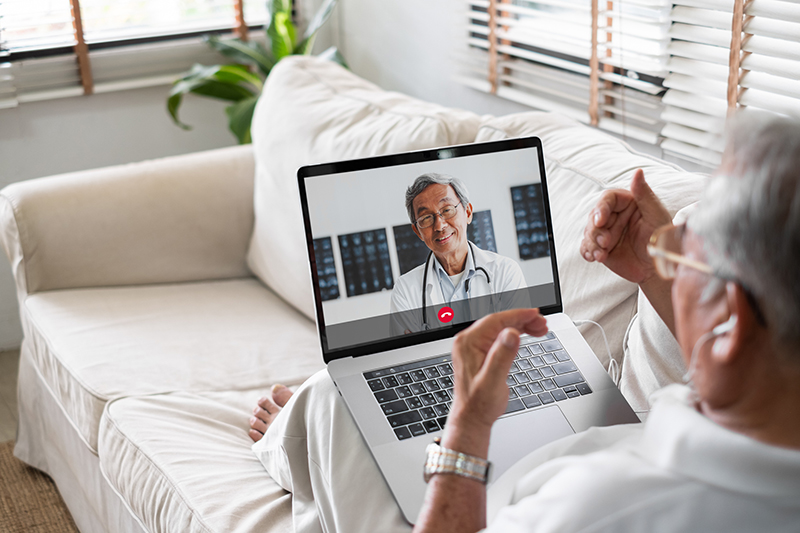
Imagine that you develop a fever, have trouble breathing, and feel like you have a stitch in your side. Worried, you head to an emergency department. The doctor diagnoses you with pneumonia and tells you that you need antibiotics delivered through your veins and extra oxygen to breath. Instead of admitting you to the hospital, the doctor sends you back home in an ambulance. In your own home, a team sets up your antibiotic infusion and oxygen tubing, gives you a watch with a biosensor that checks your heart rate, temperature, breathing, blood pressure, and oxygen level, and connects it to a device that sends your vital signs instantly back to the doctor. You get to sleep in your own bed, eat your own food, and watch whatever you want on Netflix. Meanwhile, your vital signs are being monitored remotely 24/7 by a nurse, and every six hours a nurse comes to your house to check on you and refill your antibiotic solution and oxygen. A doctor makes house calls twice a day. Once a day, a technician comes to your house to take a chest x-ray and a blood sample. After monitoring your progress for three days, the doctor decides you are well enough to be discharged from your “hospital at home.” You still need to finish your antibiotics in pill form only, but the sensors and oxygen tubing are removed. You are instructed to follow up with your primary care doctor the next week. During this entire course of treatment, you never spent the night in the hospital.
Though not exactly like the “house calls” doctors made on their patients in years past, the hospital at home concept keeps sick patients out of hospitals by providing all the traditional inpatient care needs to the patient in the comfort of his or her own home. Though this model of providing acute care to patients at home when they otherwise would have been hospitalized has been around for twenty years,1 adoption had been very slow. Physicians had concerns about safety and the ability to provide high quality care to their patients in a remote setting, insurance companies were reluctant to provide coverage of services outside the hospital, and there was little understanding of how patients and their families would feel about it.
With careful selection of patients and appropriate diagnoses and development of standardized care pathways, numerous studies have shown that the hospital at home model is associated with lower costs, shorter length of stays, better patient mobility, fewer readmissions, and health outcomes equal to being admitted to an acute care hospital.2,3 Despite the potential advantages, insurance companies had been reluctant to offer coverage for these services and hospitals were concerned about losing money from empty beds.
The COVID-19 pandemic forced a change. As hospitals rapidly filled with sick patients and ran out of beds, the hospital at home model suddenly became a necessity. In addition, new technologies including rapid adoption of telehealth enabled information flow with remote monitoring. The hospital at home model became a viable option for increasing the capacity for hospitals to care for sick patients.4
During the COVID-19 public health emergency (PHE), the Centers for Medicare & Medicaid Services (CMS) made an exception to allow payments for hospital at home services due to the scarcity of inpatient beds.5 With lower costs, improved outcomes, rapid technologic advances, and doctor and patient willingness to use telehealth services, the hospital at home model may be one solution to the rising costs of health care. Whether or not the U.S. Congress would extend the policy exceptions made during the PHE is still weighing on the balance, although there is strong bipartisan interest in improving telehealth policies. Furthermore, whether more insurance companies would follow suit by offering coverage for these services and hospitals relinquish patients for such high tech and high value house calls remain to be seen.
Author Bio:

Sharon Lum, MD, FACS
Dr. Lum is Professor and Chair of the Department of Surgery for the School of Medicine, where she also serves as Medical Director of the Breast Health Center. She is a member of the American Society of Breast Surgeons Health Equity Advisory Committee. Her research interests include quality measures and disparities in breast and other cancer outcomes and incorporation of patient reported outcomes in clinical decision-making for patients with breast diseases.
References:
- Bruce Leff, Lynda Burton, Scott L. Mader, et al. Hospital at Home: Feasibility and Outcomes of a Program To Provide Hospital-Level Care at Home for Acutely Ill Older Patients. Ann Intern Med.2005;143:798-808. [Epub ahead of print 6 December 2005]. doi:10.7326/0003-4819-143-11-200512060-00008
- Shepperd S, Iliffe S, Doll HA, Clarke MJ, Kalra L, Wilson AD, Gonçalves-Bradley DC. Admission avoidance hospital at home. Cochrane Database Syst Rev. 2016 Sep 1;9(9):CD007491. doi: 10.1002/14651858.CD007491.pub2. PMID: 27583824; PMCID: PMC6457791.
- Levine DM, Ouchi K, Blanchfield B, Saenz A, Burke K, Paz M, Diamond K, Pu CT, Schnipper JL. Hospital-Level Care at Home for Acutely Ill Adults: A Randomized Controlled Trial. Ann Intern Med. 2020 Jan 21;172(2):77-85. doi: 10.7326/M19-0600. Epub 2019 Dec 17. PMID: 31842232.
- Sitammagari K, Murphy S, Kowalkowski M, Chou SH, Sullivan M, Taylor S, Kearns J, Batchelor T, Rivet C, Hole C, Hinson T, McCreary P, Brown R, Dunn T, Neuwirth Z, McWilliams A. Insights From Rapid Deployment of a "Virtual Hospital" as Standard Care During the COVID-19 Pandemic. Ann Intern Med. 2021 Feb;174(2):192-199. doi: 10.7326/M20-4076. Epub 2020 Nov 11. PMID: 33175567; PMCID: PMC7711652.
- https://www.dhcs.ca.gov/Pages/Acute-Hospital-Care-at-Home-Program.aspx
